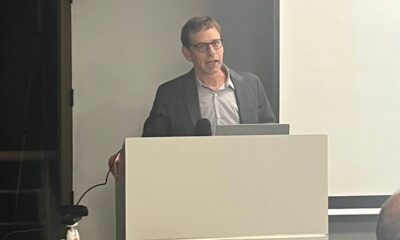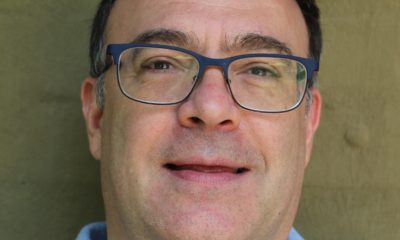
Featured Item

Bombs, borders, bonfires – SA teacher escapes Ukraine
Published
2 years agoon
South African teacher Johan Nel had a draining and dangerous journey to escape war-torn Ukraine. He recounted his experience at a SA Jewish Report webinar on 3 March 2022 titled, “Ukraine in crisis – firsthand accounts of the war”.
Nel teaches English at a Mexican school. In October last year, he decided to travel the world for a bit because he works online.
While in Turkey, he applied for a Mexican work visa at the Mexican consulate in Istanbul. When his visa was rejected due to communication errors, he reapplied for it at the Mexican embassy in Kyiv. Bombs started falling on 24 February 2022, the day he had to collect his visa.
“That morning, at half-past four, I woke up because of bomb sirens,” he said. “I immediately knew what was going on. The tension was there four or five weeks before the invasion.”
He decided to stay in his apartment. “I couldn’t get any sleep. Every two hours, you heard a bomb fall. The next day, a British Pakistani national named Mutasa Hamid contacted me. He was from the Telegram group called Foreigners Staying in Kyiv. He told me, ‘Bro, I’m alone, you’re alone, we need to get together. Evacuating a war zone alone isn’t going to work.’ On the third day, I told Mutasa, ‘We have to try to get out of here.’”
They met at a metro station in the centre of Kyiv. “The trains were packed,” Nel said. “It was chaos, with people throwing others off the train just to get in. It was like scenes out of World War II.”
The duo pursued Plan B. One of the Turkish taxi drivers on the Telegram group would drive them – an eight-hour journey – to the Polish border. The traffic on the way meant the drive took 22 hours.
“There was a 30km queue of cars waiting to enter the border,” Nel said. “We guessed it would take 70 to 90 hours.”
They couldn’t wait that long as they had handed out all their food and water to those who walked about 200km to get to the border. So, they decided to walk the last 30km.
“I threw away 50% of my clothes to make my bag lighter,” said Nel. “It took me about 15 hours. Once I got to the Polish border, it was absolute chaos, with bonfires everywhere. I heard warning shots from Ukrainian border guards. The people said they had been waiting there for three days.”
Having lost Mutasa in the crowd, Nel stood with two South African women in the queue. Many people were pushing to get to the front, so people couldn’t help but cross the line indicating the border. When one South African woman accidentally crossed it, a Ukrainian border guard kicked her.
“I’m like, ‘Man, you cannot do this,’” recounted Nel. “After a few hours, myself and a few South African girls got through the first border checkpoint. We thought it was the border. After a 2km walk, we got to the actual border. There were thousands and thousands of people, Moroccans, Arabs, Nigerians. They started fighting.”
With the border guards prioritising women and children, the South African women went through without Nel. He ended up standing there for seven hours.
Nel decided to walk back (into Ukraine). “Luckily, a van drove past me and picked me up.”
With his feet bleeding and a pulled hamstring, Nel eventually arrived in the Ukrainian city of Lviv. There, he stayed in a hotel, getting eight hours of sleep for the first time in three days. The next day, he and a South African named Johnny travelled by bus to Uzhhorod. “Military checkpoints were everywhere,” said Nel. “Ukraine officers would come into the bus. They screamed and shouted at me because I look Russian. At Uzhgorod, a Ukrainian girl said, ‘Go to the Slovakian border.’”
Once they entered the Slovakian side of the border, they were accepted with open arms. Food, free SIM cards, jackets and blankets were handed out. “Once we arrived at a city in Slovakia called Košice, we took a train straight to Budapest, where we now live with a fellow South African who is married to Hungarian woman.”
Kim Kur, who has been helping South Africans escape from Ukraine, said that what she was seeing on the WhatsApp group was completely different to what was being shown on TV.
People were trapped in their homes, hiding from Russian snipers. “People are fearing for their lives, afraid to go out to get food, afraid to get in their vehicles and make a run for it,” said Kur. (See page 9.)
Paula Slier, the Middle East bureau chief of Russia Today, said the invasion of Ukraine surprised her, her colleagues and even the Russian leadership. (See page 5.)
She said part of Russian President Vladimir Putin’s motivation was his belief that he needed to demilitarise the whole of Ukraine. He’s also objecting to the North Atlantic Treaty Organisation’s (Nato’s) expansion into former Soviet Union areas. She said the West was dealing lightly with Putin. In Russia, Putin putting his nuclear armaments on high alert was largely perceived as a reaction to threats from the West.
Steven Gruzd, who heads the Russia-Africa Project at the South African Institute of International Affairs in Johannesburg, said, “In my view, this conflict isn’t about Putin trying to reverse the result of the Cold War.”
“Putin’s endgame is probably to create a land bridge to Crimea,” said Gruzd, adding that “Putin is probably wanting to install a puppet government in Ukraine.” He said Israel had been suggested as a possible mediator. (See page 6.)
Dzvinka Kachur of the Centre for Sustainability Transitions at Stellenbosch University believes Putin wants economic control of Ukraine.
In the conflict between eastern Ukraine and Russian separatists, about 14 000 to 15 000 Ukrainians were shot between 2014 and 2022, said Kachur.
“South Africa is getting money from Putin,” she said, “so we understand why the message from the South African government isn’t clear.”
Putin needs to be brought before the International Criminal Court, said Kachur, citing his responsibility for many deaths and for destroying Ukraine.










